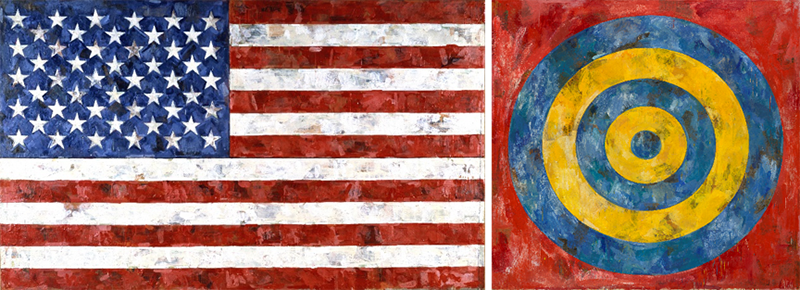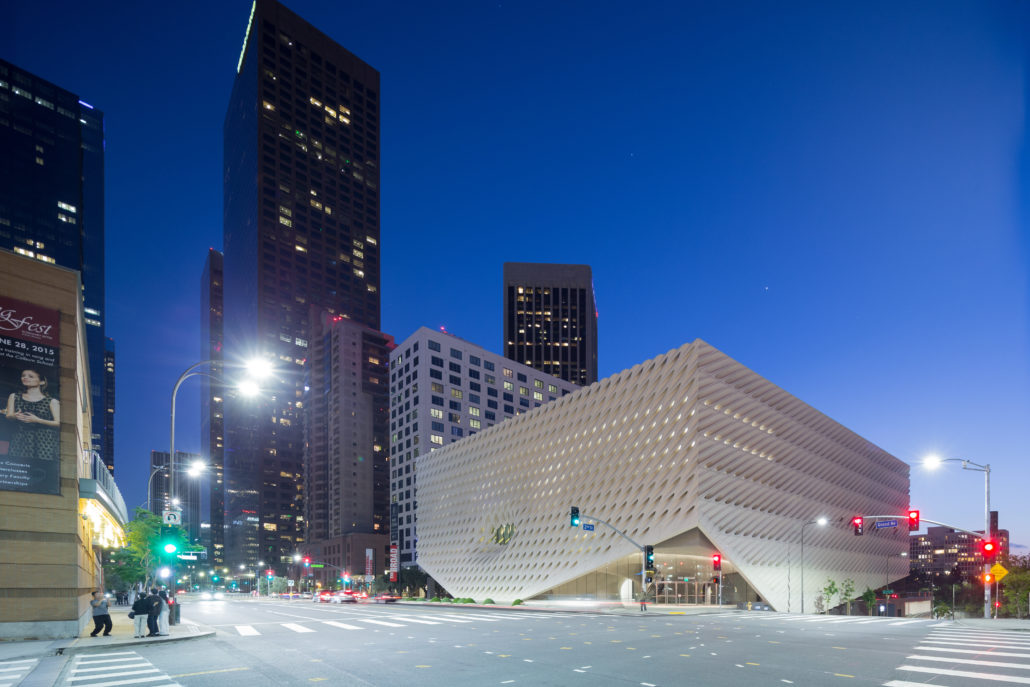
LOS ANGELES — Widely known for his iconic early images of flags, targets, maps and numbers, Jasper Johns is an artist of unparalleled importance in the last century. In the first full survey of his work in more than 20 years in the United States, The Broad is presenting six decades of rarely loaned artworks from Johns’ remarkable and inventive career—many never before seen in Los Angeles. Jasper Johns: ‘Something Resembling Truth’, a collaboration with the Royal Academy, London, will be on view from Feb. 10 until May 13, 2018. The Broad is the exclusive U.S. venue for this exhibition.
On Monday, Jan. 1, 2018 at noon PT, The Broad will release timed tickets for the entire run of the exhibition at thebroad.org. Tickets will be $25 for adults, free for children 17 and under, and will include same-day general admission for The Broad’s third floor galleries. In celebration of this rare opportunity to consider Johns’ entire career in depth, The Broad will host free First Thursdays with free standby admission to the special exhibition from 4-7 p.m. on the first Thursday of every month during the exhibition’s run (Apr. 5 and May 3, 2018). The Broad’s third floor galleries will continue to be accessible with free general admission tickets, and will show a robust selection of postwar and contemporary works from the Broad collection.
Jasper Johns: ‘Something Resembling Truth’ will feature more than 120 of the artist’s most significant paintings, sculptures, prints and drawings. With loans from dozens of museums and private collections from around the world, including significant works from the Broad collection, the exhibition will trace the evolution of the artist’s wide-ranging practice through a series of thematic chapters. The exhibition encompasses the full range of Johns’ materials, motifs and techniques—including his unique use of encaustic (heated beeswax) and found-material collage in paintings—and the innovations he has achieved in sculpture and the graphic arts by expanding the possibilities of traditional media. Johns’ use of accessible images will be thoroughly examined, seen continually transformed through the artist’s engagement with a wide range of human experiences. In a departure from a retrospective approach, Johns’ artistic achievements will be illuminated through the juxtaposition of early and late works throughout the exhibition.
The museum will be announcing an inventive slate of public programs that will further explore and contextualize the artist’s work through the performing arts and live public discussions of the essential influence of Johns on younger generations of artists.
One of the most influential and important artists to emerge in the last century, Johns has been seminal to the Broad collection. His work emerged with and has influenced numerous other Broad collection artists represented in depth, including Robert Rauschenberg, Andy Warhol, Bruce Nauman, Ed Ruscha, John Baldessari and Sherrie Levine.

About the Exhibition
Organized by the Royal Academy of Arts, London in collaboration with The Broad, Jasper Johns: ‘Something Resembling Truth’ is curated by Edith Devaney, contemporary curator at the Royal Academy, and independent curator Dr. Roberta Bernstein, author of Jasper Johns’ Catalogue Raisonné of Paintings and Sculpture, who has written and lectured extensively on contemporary artists including Johns, Ellsworth Kelly and Robert Rauschenberg. Founding Director Joanne Heyler and Associate Curator Ed Schad are the host curators at The Broad. The exhibition title is taken from a 2006 interview in which Johns said, “Yet, one hopes for something resembling truth, some sense of life, even of grace, to flicker, at least, in the work.”
At The Broad, Jasper Johns: ‘Something Resembling Truth’ will begin with an entire gallery devoted to Johns’ complex treatment of the American flag, arguably his best-known image, deployed famously at the outset of his career in the 1950s as testing ground for a new direction for 20th century art, and for decades afterward, as an enduring, compelling and ever-evolving subject evoking a variety of social meanings.
Works exclusive to The Broad’s presentation of the exhibition include Figure 7, 1955 (Los Angeles County Museum of Art); Three Flags, 1958 (The Whitney Museum of Art, New York); White Target, 1958 (private collection); In memory of my feelings, Frank O’Hara, 1961 (Museum of Contemporary Art, Chicago); Device, 1962 (Baltimore Museum of Art); Gray Alphabets, 1956 (The Menil Collection); Figure 5, 1960 (Centre Pompidou); and Flags, 1965 (Collection of the artist). Other highlights include Flag, 1958 (private collection); 0 Through 9, 1961 (private collection); Target, 1961 (The Art Institute of Chicago); Periscope (Hart Crane), 1963 (The Menil Collection, on loan from the artist); Between the Clock and the Bed, 1981 (National Gallery of Art, Washington, D.C); Ventriloquist, 1983 (Museum of Fine Arts, Houston); Summer, 1985 (Museum of Modern Art, New York); and Bridge, 1997 (private collection).
The exhibition will reveal the continuities and changes in Johns’ work throughout his career. His use of accessible and familiar motifs established a new vocabulary in painting as early as the 1950s—his treatment of iconography and the appropriation of objects and symbols made the familiar seem unknown through the distinctive, complex textures of his works. Through his groundbreaking paintings and sculptures, Johns charted a radical new course in an art world that had previously been dominated by Abstract Expressionism.
In the 1960s, he added devices within his works, including studio objects, imprints and casts of the human figure, while works from the 1970s are dominated by abstract ‘crosshatchings.’ During this time, Johns began to explore printmaking and is now one of the most celebrated printmakers today. His work continued to evolve throughout the 1980s as he introduced a variety of images that engaged with themes involving memory, sexuality and the contemplation of mortality. From this time, Johns increasingly incorporated tracings and details of works by other artists, such as Matthias Grünewald, Pablo Picasso and Edvard Munch. The works of the 1990s built on the increasing complexity of subject and reference, and by the early 2000s, Johns had embarked on the pared down and more conceptual Catenary series which, along with other recent works, shows the rich productivity and vitality of this late phase of his career.
Jasper Johns: ‘Something Resembling Truth’brings together artworks that rarely travel, including significant loans from the Museum of Contemporary Art and the Art Institute, Chicago; the Menil Collection, Houston; the Museum of Modern Art, New York; the Tate, London; the Centre Pompidou, Paris; the National Gallery of Art, Washington, D.C.; and the Philadelphia Museum of Art. In addition, the artist has generously loaned a number of his works to the exhibition.
Jasper Johns: ‘Something Resembling Truth’ will be accompanied by an exhibition catalogue featuring writings by the curators Devaney and Bernstein, as well as essays from curator and critic Robert Storr, art historian Hiroko Ikegami and writer Morgan Meis. The contributing authors will discuss Johns’ extensive body of work from viewpoints of literature, contemporary culture and international significance.
About the Artist
Johns was born in Augusta, Georgia in 1930 and raised in South Carolina. He moved to New York in 1948 and returned in 1953 after two years of service in the U.S. Army. Johns’ works became widely known after his first solo exhibition at the Leo Castelli Gallery in 1958. Over the course of his career, he has collaborated with an array of other artists, including visual artists Andy Warhol and Robert Rauschenberg, playwright Samuel Beckett and choreographer Merce Cunningham, serving as artistic advisor to the Merce Cunningham Dance Company for over a decade. The artist currently lives and works in Sharon, Conn.
Johns has held solo exhibitions throughout the world at institutions including the Museum of Modern Art and the Metropolitan Museum of Art, New York; the National Gallery of Art, Washington, D.C.; the Centre Pompidou, Paris; the Kunstmuseum Basel; and the San Francisco Museum of Modern Art. Johns won the Grand Prize for Painting at the Venice Biennale in 1988, and was awarded the Presidential Medal of Freedom in 2011.

About The Broad
The Broad is a contemporary art museum founded by philanthropists Eli and Edythe Broad on Grand Avenue in downtown Los Angeles. Designed by Diller Scofidio + Renfro in collaboration with Gensler, the museum offers free general admission. The Broad is home to the 2,000 works of art in the Broad collection, which is among the most prominent holdings of postwar and contemporary art worldwide, and presents an active program of rotating temporary exhibitions and innovative audience engagement. The 120,000-square-foot building features two floors of gallery space and is the headquarters of The Broad Art Foundation’s worldwide lending library, which has actively loaned collection works to museums around the world since 1984. Since opening in September 2015, The Broad has welcomed more than 1.6 million visitors.
For more information on The Broad and to sign up for updates, please visit thebroad.org.
# # #

